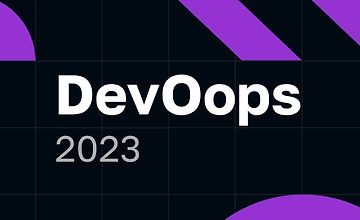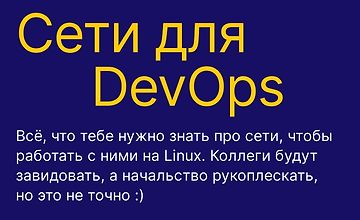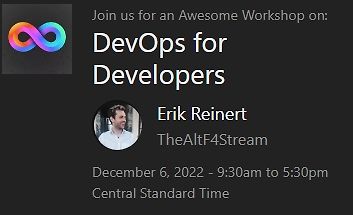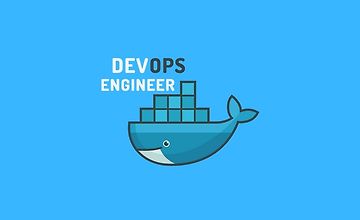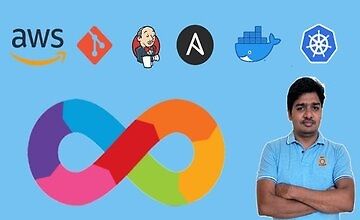Урок 1.
00:07:10
Introduction
Урок 2.
00:03:48
Cloud Types: Private/On-premises, Public and Hybrid Cloud
Урок 3.
00:01:31
Multi-Cloud Strategy
Урок 4.
00:02:53
Evolution of Cloud Platforms: Cloud Hosting Models: IaaS - CaaS - PaaS - FaaS
Урок 5.
00:04:34
Cloud-Native Application Architecture
Урок 6.
00:02:57
Evolution of Application Architectures: Monolithic, Microservices, Serverless
Урок 7.
00:04:54
Deep Dive into Cloud-Native Pillars - Course Section Flow
Урок 8.
00:04:22
Way of Learning - The Course Flow
Урок 9.
00:07:05
Hands-on Projects
Урок 10.
00:03:35
How to Follow the Course & Course Slides
Урок 11.
00:02:28
What is Cloud-Native ?
Урок 12.
00:01:37
Cloud Native Definition from CNCF
Урок 13.
00:01:27
What Is Cloud Native Architecture ?
Урок 14.
00:03:17
Cloud Native Architecture Design Principles and Key Characteristics
Урок 15.
00:01:40
Benefits of Cloud-Native Architectures
Урок 16.
00:02:57
Challenges of Cloud-Native Architectures
Урок 17.
00:05:47
The Cloud Path of Legacy Applications - Modernization of Legacy Apps with Cloud
Урок 18.
00:00:48
Introduction - Cloud-Native Fundamentals - Conway's Law and 12 Factor App
Урок 19.
00:01:54
The Conway's Law
Урок 20.
00:03:40
The impact of Conway's Law on Cloud-Native Microservices
Урок 21.
00:04:56
12-Factors - The Twelve-Factor Application
Урок 22.
00:01:35
I. Codebase - The Twelve-Factor Application
Урок 23.
00:02:26
II. Dependencies - The Twelve-Factor Application
Урок 24.
00:02:27
III. Config - The Twelve-Factor Application
Урок 25.
00:02:14
IV. Backing services - The Twelve-Factor Application
Урок 26.
00:03:15
V. Build, release, run - The Twelve-Factor Application
Урок 27.
00:01:33
VI. Processes - The Twelve-Factor Application
Урок 28.
00:01:24
VII. Port binding - The Twelve-Factor Application
Урок 29.
00:02:06
VIII. Concurrency - The Twelve-Factor Application
Урок 30.
00:02:23
IX. Disposability - The Twelve-Factor Application
Урок 31.
00:01:29
X. Dev/prod parity - The Twelve-Factor Application
Урок 32.
00:01:33
XI. Logs - The Twelve-Factor Application
Урок 33.
00:01:32
XII. Admin processes - The Twelve-Factor Application
Урок 34.
00:00:26
Introduction - Cloud-Native Deep Dive - Landscape, TrialMap and Pillars
Урок 35.
00:01:56
Cloud Native Computing Foundation (CNCF)
Урок 36.
00:04:37
Quick Tour on Cloud Native Computing Foundation (CNCF)
Урок 37.
00:06:33
What Is the CNCF Landscape ?
Урок 38.
00:08:20
Deep Dive into CNCF Landscape Categories
Урок 39.
00:01:53
Complicated with CNCF Projects ? - Funny Break
Урок 40.
00:04:34
CNCF Cloud Native Trail Map
Урок 41.
00:01:22
The Four Pillars of Cloud-Native Applications
Урок 42.
00:04:54
All Cloud Native Pillars - Extended for Course Structure
Урок 43.
00:01:51
Introduction to Pillar1: Microservices
Урок 44.
00:03:28
12-Factor App and Cloud-native Trial Map - Microservices
Урок 45.
00:02:57
Evolution of Architectures; Monolithic, Microservices, Serverless
Урок 46.
00:01:26
What are Microservices ?
Урок 47.
00:01:51
What is Microservices Architecture ?
Урок 48.
00:03:09
Microservices Characteristics
Урок 49.
00:04:04
Benefits of Microservices Architecture
Урок 50.
00:04:03
Challenges of Microservices Architecture
Урок 51.
00:03:13
When to Use Microservices Architecture - Best Practices
Урок 52.
00:03:10
When Not to Use Microservices - Anti-Patterns of Microservices
Урок 53.
00:02:39
Monolithic vs Microservices Architecture Comparison
Урок 54.
00:02:37
The Database-per-Service Pattern - Polygot Persistence
Урок 55.
00:04:23
Explore: Languages and Frameworks for Microservices
Урок 56.
00:05:23
Explore: Cloud-Native Microservices Frameworks
Урок 57.
00:04:05
Explore: Cloud Managed and Serverless Microservices Frameworks
Урок 58.
00:01:00
Design: Cloud-Native Microservices Architecture - Way of Learning
Урок 59.
00:04:12
Understand E-Commerce Domain: Analysis and Decompose E-Commerce Microservices
Урок 60.
00:01:50
Identifying and Decomposing Microservices for E-Commerce Domain
Урок 61.
00:03:19
Design: Cloud-Native E-commerce Microservices Architecture
Урок 62.
00:03:12
Choose Microservices Language and Frameworks for Cloud-Native Microservices
Урок 63.
00:08:35
Reference Project: .Net Microservices - Cloud-Native E-commerce App
Урок 64.
00:09:15
Reference Project: AWS Serverless Microservices - Cloud-Native E-commerce App
Урок 65.
00:02:29
Introduction - Hands-on: Develop a RESTful Microservices with CRUD endpoints
Урок 66.
00:02:00
Primary Programming Languages and Frameworks among Microservices Developers
Урок 67.
00:04:38
Why .Net for Microservices Development ?
Урок 68.
00:05:20
Install Prerequisites
Урок 69.
00:08:31
Developing Product Microservices
Урок 70.
00:07:04
Run the Application - Product Microservices
Урок 71.
00:01:57
Create Product Microservices with AWS Serverless Services: AWS Lambda, API Gw
Урок 72.
00:04:42
Hands-on: Create Product Microservices with AWS Lambda, API Gateway and DynamoDB
Урок 73.
00:01:26
Introduction to Pillar2: Containers
Урок 74.
00:03:25
12-Factor App and Cloud-native Trial Map - Containers
Урок 75.
00:06:59
Evolution of Cloud Platforms: Cloud Hosting Models: IaaS - CaaS - PaaS - FaaS
Урок 76.
00:02:45
What are Container ?
Урок 77.
00:02:49
Why use Containers for developing Cloud-native Microservices ?
Урок 78.
00:03:04
Best Practices of using Containers
Урок 79.
00:02:52
How Containers Works ?
Урок 80.
00:02:17
What is Container Runtimes ?
Урок 81.
00:02:45
What is a Container Registry ?
Урок 82.
00:02:39
Containerization: Running Microservices in Containers
Урок 83.
00:00:56
What is Docker ?
Урок 84.
00:01:57
Docker Containers, Images, and Registries
Урок 85.
00:03:29
Docker Architecture
Урок 86.
00:04:04
Explore Container tools: Container Runtimes, Registries, Deployments
Урок 87.
00:04:24
Explore: Container Registries
Урок 88.
00:03:36
Explore: Container Deployment Options
Урок 89.
00:07:36
Explore: Cloud Container Services: Abstraction Level of Container Deployments
Урок 90.
00:03:04
Explore The Most Popular Container Images: Redis, Postgres, ElasticSearch, Kafka
Урок 91.
00:03:38
Design: Cloud-Native E-commerce Microservices Architecture with Containers
Урок 92.
00:04:28
Reference Project: .Net Microservices - Cloud-Native E-commerce App
Урок 93.
00:11:27
Build and Run Microservices with Docker Compose
Урок 94.
00:01:18
Introduction - Hands-on: Containerize .Net Microservices with Docker
Урок 95.
00:01:29
Install Prerequisites
Урок 96.
00:05:38
Write Dockerfile for Product Microservices
Урок 97.
00:03:21
Create Docker Image for Product Microservices
Урок 98.
00:06:56
Run Docker Image for Product Microservices
Урок 99.
00:04:28
Push Docker Image to Docker Hub for Product Microservices
Урок 100.
00:06:24
Deploy Container to Cloud: AWS Apprunner, Google Cloud Run, Azure Container Inst
Урок 101.
00:07:42
Prepare your AWS Environment: AWS Account, IAM User, Programmatic Access Key
Урок 102.
00:06:41
Download and Configure AWS CLI for Programmatic Access
Урок 103.
00:05:54
Hands-on: Pushing Docker Image to Amazon Elastic Container Registry (ECR)
Урок 104.
00:06:40
Deploy ProductService Container to AWS AppRunner
Урок 105.
00:02:00
IMPORTANT - CLEAR AWS RESOURCES
Урок 106.
00:01:25
Introduction to Container Orchestrators
Урок 107.
00:02:13
12-Factor App and Cloud-native Trial Map - Container Orchestrators
Урок 108.
00:02:12
Cloud-native Trial Map - Container Orchestrators
Урок 109.
00:02:29
Why need Orchestrator for Containers ?
Урок 110.
00:02:36
What are Container Orchestrators ?
Урок 111.
00:04:19
Container Orchestrators Usage for Cloud-native Microservices
Урок 112.
00:03:27
Best Practices of using Container Orchestrators
Урок 113.
00:03:28
How Container Orchestrators works ?
Урок 114.
00:03:49
Explore: Container Orchestrator tools: Kubernetes, Docker Swarm, Apache Mesos
Урок 115.
00:05:04
Explore: Cloud Container Orchestrator tools: EKS, GKS, AKS, Red Hat OpenShift
Урок 116.
00:03:36
Datadog Container Reports: Kubernetes is defacto standard for Containers
Урок 117.
00:03:48
Design: Cloud-Native E-commerce Microservices Architecture with Container Orch
Урок 118.
00:02:30
Design with Managed Kubernetes Services - Cloud-Native E-commerce Microservices
Урок 119.
00:00:38
Introduction - Deep Dive into Kubernetes - Defacto Standart for Containers
Урок 120.
00:04:03
CNCF 2022 Annual Survey - The year cloud native became the new normal
Урок 121.
00:03:14
Kubernetes is Emerging as the 'Operating System' of the Cloud
Урок 122.
00:02:19
Cloud-Native Landscape and Trial Map - Kubernetes: Container Orchestrator
Урок 123.
00:01:09
What Is Kubernetes and why we use them for microservices deployments ?
Урок 124.
00:01:53
Uses Cases of Kubernetes
Урок 125.
00:04:41
Kubernetes Architecture
Урок 126.
00:04:35
Kubernetes Components: Pods, ReplicaSet, Deployments, Service
Урок 127.
00:04:37
How Kubernetes Works
Урок 128.
00:03:44
Declarative and Imperative way of Kubernetes
Урок 129.
00:00:53
Introduction - Hands-on: Deploy Microservices to Kubernetes
Урок 130.
00:02:06
Install Minikube and kubectl
Урок 131.
00:05:08
Getting Started with Minikube
Урок 132.
00:11:26
ASP.NET Container Expose Port - CONFIGURE TO LISTEN - 0.0.0.0:8080
Урок 133.
00:04:24
Create a Pod
Урок 134.
00:08:27
Apply a Pod in K8s
Урок 135.
00:03:16
Why Should not Create Pod on Kubernetes ?
Урок 136.
00:05:05
Create a Deployment on Kubernetes
Урок 137.
00:03:47
Apply a Deployment in K8s
Урок 138.
00:06:40
Create a Service on K8s
Урок 139.
00:04:56
Apply a Service in K8s
Урок 140.
00:03:08
Best Practice of Creating Deployment and Services for Microservices
Урок 141.
00:10:04
Create Ingress for External Access of Product Microservice
Урок 142.
00:08:40
Create ConfigMaps and Secrets for Product Microservice
Урок 143.
00:09:53
Scale a Container Instance in Kubernetes
Урок 144.
00:04:30
Kubernetes Deploy and Service with Minikube
Урок 145.
00:03:40
Clean up resources
Урок 146.
00:00:31
Introduction - Helm : Managing Kubernetes Applications with Helm
Урок 147.
00:02:09
Cloud-Native Landscape and Trial Map - Helm: Managing Kubernetes Applications
Урок 148.
00:04:26
What is Helm and Helm Charts ?
Урок 149.
00:04:33
Benefits of Helm Charts and Artifact Hub for Centralized Repository
Урок 150.
00:03:19
How Helm Charts is works ?
Урок 151.
00:01:54
Understanding Helm Chart Structure
Урок 152.
00:03:57
Install and Use Helm
Урок 153.
00:15:28
Getting Started with Helm: Install and Launch Wordpress Helm from ArtifactHub
Урок 154.
00:16:27
Hands-on Lab: Deploy Product Microservices with Helm Charts
Урок 155.
00:01:36
Introduction to Cloud-Native Communications
Урок 156.
00:01:49
12-Factor App and Cloud-native Trial Map - Cloud-Native Communications
Урок 157.
00:01:41
Cloud-native Trial Map - Cloud-Native Communications
Урок 158.
00:03:23
Communications in Cloud-Native Architectures
Урок 159.
00:04:33
Microservices Communication Types: Synchronous or Asynchronous Communication
Урок 160.
00:05:29
Microservices Communication Styles: Request-Driven or Event-Driven Architecture
Урок 161.
00:01:31
Microservices Synchronous Communications and Best Practices
Урок 162.
00:03:04
Designing HTTP based RESTful APIs for Microservices
Урок 163.
00:01:36
gRPC: High Performance Remote Procedure Calls
Урок 164.
00:01:10
How gRPC works ?
Урок 165.
00:02:00
gRPC Usage in Microservices Communication
Урок 166.
00:02:47
CN Communication Patterns: API Gateway Pattern
Урок 167.
00:03:15
A Request Flow of API Gateway Pattern
Урок 168.
00:03:22
CN Communication Patterns: Service Registry/Discovery Pattern
Урок 169.
00:04:10
CN Communication Patterns: Sidecar Pattern
Урок 170.
00:03:14
CN Communication Patterns: Service Mesh Pattern
Урок 171.
00:03:30
Service Mesh Communication in Cloud-Native Microservices
Урок 172.
00:01:24
Explore: CN Communication tools: Service Proxy (envoy), API Gateway(kong)
Урок 173.
00:04:24
Explore: CN Communication tools: Service Proxy (envoy, nginx, haproxy)
Урок 174.
00:04:40
Explore: CN Communication tools: API Gateway(kong, krakenD, kubeGateway)
Урок 175.
00:04:12
Explore: CN Communication tools: Service Meshes (istio, linkerd)
Урок 176.
00:02:47
Explore: Cloud Serverless Communication tools: AWS, Azure Service Proxy, API Gw
Урок 177.
00:02:04
Service Meshes are still early and Istio dominates usage
Урок 178.
00:04:09
Design: Cloud-Native E-commerce Microservices Architecture with Service Meshes
Урок 179.
00:01:49
Design with Cloud Managed Services - AWS API Gateway, Service Mesh
Урок 180.
00:01:34
Introduction Hands-on: Deploy Microservices to Kubernetes w/ Service Mesh Istio
Урок 181.
00:03:56
What is Istio Service Mesh and How Istio Service Mesh works ?
Урок 182.
00:06:38
Getting Started Hands-on - The Architecture with Istio and Envoy
Урок 183.
00:02:47
Download and Install Istio Service Mesh onto Minikube K8s cluster
Урок 184.
00:01:48
Install Istio
Урок 185.
00:04:42
Deploy the Microservices Application
Урок 186.
00:05:57
Open the Application to Outside Traffic with Istio Ingress Gateway
Урок 187.
00:06:12
View the dashboard - Deploy the Kiali dashboard, along with Prometheus, Grafana
Урок 188.
00:06:19
Analysis the Dashboard
Урок 189.
00:05:05
Uninstall Istio Workloads
Урок 190.
00:01:57
Introduction to Cloud-Native Backing Services: Databases, Caching,Message Broker
Урок 191.
00:01:46
12-Factor App - Cloud-Native Backing Services
Урок 192.
00:01:44
Cloud-native Trial Map - Cloud-Native Backing Services
Урок 193.
00:03:57
Dynatrace Kubernetes Report - Kubernetes Growth Areas are Open Source Databases
Урок 194.
00:06:50
Backing Services for Cloud-Native Microservices
Урок 195.
00:01:58
Starting to CN Data Management, Caching, Message Brokers (K8s and Serverless)
Урок 196.
00:00:59
Introduction to CN Data Management (K8s and Serverless Databases)
Урок 197.
00:01:55
Cloud-native Trial Map – Backing Services: Databases
Урок 198.
00:04:39
Database as a Service - DBaaS for Cloud-Native Microservices
Урок 199.
00:02:14
Relational Databases
Урок 200.
00:01:14
No-SQL Databases
Урок 201.
00:03:23
NoSQL Databases Types - Document, Key-value, Graph-based, Column-based Databases
Урок 202.
00:02:48
When to Use Relational Databases ?
Урок 203.
00:03:59
When to Use No-SQL Databases ?
Урок 204.
00:03:32
Best Practices When Choosing Data Store - Use Right Tool for Right Job
Урок 205.
00:04:29
How to Choose a Database for Microservices
Урок 206.
00:03:02
NewSQL Databases
Урок 207.
00:03:10
Comparison with Relational, NoSQL and NewSQL Databases
Урок 208.
00:06:50
The Rise of the Kubernetes Native Database and Architecture
Урок 209.
00:02:26
Most Usage Databases in Kubernetes for Cloud-Native Apps
Урок 210.
00:01:51
Explore: CN Databases: Horizontally Scalable Distributed Cloud-native Databases
Урок 211.
00:03:24
Explore: Relational Databases: PostgreSQL, MySQL, Oracle, SQL Server
Урок 212.
00:03:11
Explore: NoSQL Databases: MongoDB, Redis, Cassandra
Урок 213.
00:04:00
Explore: NewSQL Kubernetes Database: Vitess, TiDB, TiKV, CockroachDB, YugabyteDB
Урок 214.
00:07:30
Explore: Kubernetes Databases: YugabyteDB: The Scalable Cloud Native Database
Урок 215.
00:02:44
Explore: CN Kubernetes Databases: Vitess: Scalable. Reliable. MySQL-compatible.
Урок 216.
00:05:51
Explore: CN Kubernetes Databases: CockroachDB: A distributed SQL database built
Урок 217.
00:06:01
Explore: Cloud Serverless Databases: Amazon DynamoDB, Azure CosmosDB, Google DB
Урок 218.
00:02:05
Design: Cloud-Native E-commerce Microservices with Relational and NoSQL Database
Урок 219.
00:03:29
Design: Cloud-Native E-commerce Microservices with NewSQL Kubernetes Databases
Урок 220.
00:03:27
Design with Cloud Serverless Databases: AWS DynamoDB, Aurora DB, Azure CosmosDB
Урок 221.
00:03:37
Introduction - Hands-on: Deploy CockroachDB in a Single Kubernetes Cluster
Урок 222.
00:03:08
What is Kubernetes Operator and Why use Operators ?
Урок 223.
00:01:22
Step 1. Start Kubernetes - minikube start
Урок 224.
00:05:02
Step 2. Start CockroachDB - Deploy CockroachDB in a Single Kubernetes Cluster
Урок 225.
00:04:31
Step 2.1 Start CockroachDB - Initialize the cluster - Apply the custom resource
Урок 226.
00:06:20
Step 3. Use the built-in SQL client
Урок 227.
00:04:34
Step 4. Access the DB Console
Урок 228.
00:04:42
Step 5. Simulate node failure and node scales
Урок 229.
00:03:42
Step 6. Stop the cluster
Урок 230.
00:02:38
Introduction - Hands-on: Building RESTful Microservices with Serverless
Урок 231.
00:01:57
What Is Amazon DynamoDB ?
Урок 232.
00:03:42
Amazon DynamoDB Core Concepts - Tables, Items, Attributes, Indexes
Урок 233.
00:00:57
Create a DynamoDB Table
Урок 234.
00:04:24
Create a Lambda Function
Урок 235.
00:04:00
Create an API Gateway
Урок 236.
00:02:27
Test - RESTful Microservices with AWS Lambda, Api Gateway and DynamoDb
Урок 237.
00:02:10
AWS Console microservice-http-endpoint Lambda Blueprint
Урок 238.
00:01:02
Resource Cleanup
Урок 239.
00:01:27
Introduction to CN Caching (K8s and Serverless Caching)
Урок 240.
00:01:43
Cloud-native Trial Map – Backing Services: Caching
Урок 241.
00:01:31
What is Caching ?
Урок 242.
00:01:20
Types of Caching
Урок 243.
00:02:54
Distributed Caching in Microservices
Урок 244.
00:01:28
Cache Hit and Cache Miss
Урок 245.
00:05:01
Caching Strategies in Distributed Caching for Microservices
Урок 246.
00:03:29
Cache-Aside Pattern for Microservices
Урок 247.
00:04:19
Best Practices of using Cache in Cloud-native Apps
Урок 248.
00:01:38
Explore: CN Caching: Horizontally scalable Distributed Caches
Урок 249.
00:03:21
Explore: CN Distributed Caches: Redis, Memcached, TiKV, etcd
Урок 250.
00:02:51
Explore: Cloud Serverless Caches: Amazon ElastiCache, Azure Cache for Redis
Урок 251.
00:01:33
Explore: Upstash Redis: Serverless fully managed globally distributed Redis
Урок 252.
00:04:25
Design: Cloud-Native E-commerce Microservices with Distributed Caching
Урок 253.
00:02:24
Design with Cloud Serverless Caches - AWS ElastiCache, Azure Cache for Redis
Урок 254.
00:01:52
Introduction - Hands-on: Deploy Redis Cache in a Single Kubernetes Cluster
Урок 255.
00:03:09
Hands-on: Deploy Redis Cache in a Single Kubernetes Cluster with Minikube
Урок 256.
00:03:06
Start Redis - Deploying Redis Cluster in Kubernetes with Bitnami Helm Charts
Урок 257.
00:03:53
Use the built-in Redis Client - Run Redis Commands on Redis Interactive Terminal
Урок 258.
00:05:55
Simulate Redis Node Failure and Node Scales
Урок 259.
00:02:54
Stop the cluster - Clear Resources
Урок 260.
00:01:52
Hands-on: Create Cache Cluster with Amazon ElastiCache for Redis
Урок 261.
00:05:24
Create Redis Cache Cluster with Amazon ElastiCache for Redis
Урок 262.
00:01:17
Introduction to Cloud-Native Message Brokers (Async communication, event-driven)
Урок 263.
00:02:41
Cloud-native Trial Map – Backing Services: Message Brokers
Урок 264.
00:03:22
Microservices Asynchronous Communication
Урок 265.
00:02:15
Benefits of Asynchronous Communication
Урок 266.
00:01:43
Challenges of Asynchronous Communication
Урок 267.
00:02:45
Fan-Out Publish/Subscribe Messaging Pattern
Урок 268.
00:03:16
Topic-Queue Chaining & Load Balancing Pattern
Урок 269.
00:01:57
Event-Driven Microservices Architecture
Урок 270.
00:01:59
Real-time Processing and High Volume Events in Event-Driven Microservices
Урок 271.
00:02:23
Event Hubs and Event Streaming in Event-Driven Microservices Architecture
Урок 272.
00:02:26
Real-world Examples of Event-Driven Microservices Architecture
Урок 273.
00:01:46
Explore: CN Message Broker: Horizontally Scalable Distributed
Урок 274.
00:02:33
Explore: CN Message Brokers: Kafka, RabbitMQ, Redis Pub/Sub, cloudevents
Урок 275.
00:01:38
What is Apache Kafka ?
Урок 276.
00:01:54
Apache Kafka Use Cases
Урок 277.
00:04:11
Kafka Components: Topic, Partitions, Offset and Replication Factor
Урок 278.
00:01:20
What is RabbitMQ ?
Урок 279.
00:01:29
RabbitMQ Components: Producer, Queue, Consumer, Message, Exchange, Binding, FIFO
Урок 280.
00:05:07
Explore: Cloud Serverless Message Brokers: Amazon SNS, EventBridge, Azure Bus
Урок 281.
00:03:27
Explore: Upstash Kafka: Message Broker and Memphis.dev for Event Streaming
Урок 282.
00:02:35
Design: Cloud-Native E-commerce Microservices with Distributed Message Broker
Урок 283.
00:02:31
Design: Event-Driven E-commerce Microservices Architecture with Event Hubs
Урок 284.
00:03:48
Design with Cloud Serverless Message Brokers - Amazon SNS - EventBridge
Урок 285.
00:01:26
Introduction - Hands-on: Deploy Kafka in Kubernetes Cluster with Minikube
Урок 286.
00:02:51
Apache Kafka Cluster Architecture
Урок 287.
00:02:23
Apache Kafka Core APIs
Урок 288.
00:02:14
Hands-on: Deploy Kafka Message Broker in a Single Kubernetes Cluster w/ Minikube
Урок 289.
00:02:14
Start Kafka - Deploying Kafka Cluster in Kubernetes with Bitnami Helm Charts
Урок 290.
00:03:52
Use the built-in Kafka Client - Publish and Subscribe Topic with sending message
Урок 291.
00:03:47
Simulate Kafka Node Failure and Node Scales
Урок 292.
00:02:31
Stop the cluster - Clear Resources
Урок 293.
00:01:18
Introduction Hands-on: Amazon SNS Notifications Topic Subscribe From AWS Lambda
Урок 294.
00:01:00
Amazon SNS Features and Benefits
Урок 295.
00:01:52
Amazon SNS Common Use Cases
Урок 296.
00:01:23
Create Notification Amazon SNS topic
Урок 297.
00:02:27
Create Lambda Function for Asnyc Invocations from Amazon SNS
Урок 298.
00:03:06
Create Lambda Subscription to Amazon SNS topic
Урок 299.
00:03:10
Develop Lambda function for incoming event from Amazon SNS topic
Урок 300.
00:01:48
Publish Message from Amazon SNS
Урок 301.
00:00:36
Clean up Resources
Урок 302.
00:01:39
Introduction to Scalability: Kubernetes Horizontal Pod Autoscaler (HPA) and KEDA
Урок 303.
00:02:14
12-Factor App - Cloud-Native Scalability
Урок 304.
00:01:39
Cloud-native Trial Map - Cloud-Native Scalability
Урок 305.
00:01:32
What is Scalability ?
Урок 306.
00:01:46
Vertical Scaling - Scale up
Урок 307.
00:01:17
Horizantal Scaling - Scale out
Урок 308.
00:04:48
Scaling Cloud-native Applications in Kubernetes - Kubernetes Scalability Options
Урок 309.
00:01:30
Best Practices of Scaling Cloud-native Applications in Kubernetes
Урок 310.
00:05:59
KEDA Event-driven Autoscaling Cloud-native Applications in Kubernetes
Урок 311.
00:06:25
Explore:CN Scalability tools: KEDA, Knative, Kubeless, Virtual Kubelet, OpenFunc
Урок 312.
00:03:17
Explore: Cloud Serverless Scalability: AWS Fargate, Azure Container Apps
Урок 313.
00:05:23
Design: Cloud-Native E-commerce Microservices with Cloud-Native Scalability
Урок 314.
00:04:36
Design: Cloud Serverless Scalability: AWS Fargate, Azure Container Apps
Урок 315.
00:01:03
Hands-on: Scale Kubernetes Pods (VPA,HPA,KEDA) on a Kubernetes Cluster Minikube
Урок 316.
00:07:19
Step 1. Manually Horizontal and Vertical scaling pods into Kubernetes Cluster
Урок 317.
00:13:09
Step 2. Horizontal Pod Autoscaler (HPA) to auto scale pods on a Kubernetes
Урок 318.
00:03:44
Why needed Kubernetes Event-Driven Autoscaling (KEDA) instead of Horizontal Pod
Урок 319.
00:22:22
Step 3. Kubernetes Event-Driven Autoscaling (KEDA) to auto scale pods on a K8s
Урок 320.
00:11:25
Hands-on: Auto-scaling Spring Boot Microservices in Kubernetes with Prometheus
Урок 321.
00:04:19
Introduction - Deploy on Cloud Serverless Kubernetes - AWS Fargate for EKS
Урок 322.
00:03:45
Dynatrace Report: Kubernetes moved to the cloud in 2022
Урок 323.
00:03:25
Datadog Report: Serverless Kubernetes grow for all major public clouds
Урок 324.
00:03:19
AWS Compute Services: AWS App Runner, ECS, EKS, Fargate, AWS Lambda
Урок 325.
00:01:59
Hands-on: Deploying Microservices on Amazon EKS Fargate
Урок 326.
00:04:20
Step 1. Installing or updating eksctl to interact Kubernetes Cluster on EKS
Урок 327.
00:06:38
Step 2. Create an EKS Cluster with Fargate using eksctl
Урок 328.
00:03:18
Step 3. Deploy Nginx microservices on EKS Cluster w/ Fargate using eksctl
Урок 329.
00:03:43
Expose Nginx Service on EKS Cluster w/ Fargate using eksctl
Урок 330.
00:04:18
Remember Product Microservice
Урок 331.
00:06:17
Step 4. Create an ECR repository and Push Docker Image to Container Registry
Урок 332.
00:07:47
Step 5. Deploy Product microservices on EKS Cluster w/ Fargate using eksctl
Урок 333.
00:04:52
AWS Fargate Auto-scale Deploy Product microservices on EKS Cluster
Урок 334.
00:06:55
Clean Up Resources - IMPORTANT
Урок 335.
00:01:51
Introduction to Pillar7: Devops, CI/CD, IaC and GitOps
Урок 336.
00:01:32
12-Factor App and Cloud-native Trial Map - Devops CI/CD
Урок 337.
00:00:59
Cloud-native Trial Map - Devops and CI/CD
Урок 338.
00:01:38
Devops in Cloud-native Applications: Devops/DevSecOps, CI/CD, IaC, GitOps
Урок 339.
00:02:24
What is DevOps ? How DevOps is Used in Cloud-Native Microservices ?
Урок 340.
00:02:17
What is DevSecOps ? - Key Aspects of DevSecOps
Урок 341.
00:03:06
DevOps Stages: Software Development and Deployment Lifecycle
Урок 342.
00:02:45
Explore: DevOps Tools
Урок 343.
00:02:58
What is CI/CD ? How CI/CD used in Cloud-native Microservices ?
Урок 344.
00:03:19
CI/CD Pipeline Steps for Microservices Deployments
Урок 345.
00:03:12
CI/CD Flow and Tools for Microservices Deployments
Урок 346.
00:02:26
Deployment Strategies for Microservices: Blue-green, rolling and canary deploy
Урок 347.
00:01:48
Explore: CI/CD Pipelines
Урок 348.
00:04:54
Explore: CI/CD Pipelines: GitHub Actions, GitLab CI/CD, Jenkins X, CircleCI
Урок 349.
00:01:35
What is GitHub Actions ?
Урок 350.
00:02:42
How GitHub Actions work - Components of GitHub Actions
Урок 351.
00:06:30
Deploy Microservices to Kubernetes with GitHub Actions
Урок 352.
00:03:25
Explore: Cloud Serverless CI/CD Pipelines: Azure Pipelines, AWS CodePipeline
Урок 353.
00:02:31
What is IaC ? How IaC used in Cloud-native Microservices ?
Урок 354.
00:02:18
IaC usage in Cloud-native Microservices
Урок 355.
00:01:42
Explore: IaC Tools
Урок 356.
00:04:47
Explore: IaC Tools: Terraform, Ansible, Puppet, Chef, Pulumi
Урок 357.
00:02:38
Explore: Terraform - Automate infrastructure on any cloud with Terraform
Урок 358.
00:03:38
Terraform IaC Steps - How Terraform Works ?
Урок 359.
00:04:26
Explore: Cloud Serverless IaC Tools: AWS CloudFormation, SAM, CDK,Azure Resource
Урок 360.
00:03:16
What is GitOps ? How GitOps used in Cloud-native Microservices ?
Урок 361.
00:01:35
CNCF 2022 Annual Survey - Organizations Favor GitOps
Урок 362.
00:02:13
Key Principles of GitOps
Урок 363.
00:04:35
How GitOps Works ? - Steps of GitOps workflow
Урок 364.
00:04:09
GitOps Real-world Use Case - Black Friday Sale E-Commerce
Урок 365.
00:01:45
Explore: GitOps Tools
Урок 366.
00:01:56
CNCF Survey GitOps Tools - Argo and Flux Graduated Projects
Урок 367.
00:03:29
Explore: GitOps tools: ArgoCD, Flux, Jenkins X, Codefresh, Tekton
Урок 368.
00:01:56
Explore: Argo CD - GitOps Continuous Delivery Tool for Kubernetes
Урок 369.
00:05:26
Argo CD deploy microservices in Kubernetes with CI/CD
Урок 370.
00:05:40
Design: Cloud-Native E-commerce Microservices with Devops, CI/CD, IaC and GitOps
Урок 371.
00:01:51
Hands-on: Terraform IaC provision AWS EC2 instance
Урок 372.
00:04:04
Terraform Workflow and Development Loop w/ Terraform Commands
Урок 373.
00:03:38
Step 1. Install and Setup Terraform
Урок 374.
00:05:41
Terraform Providers
Урок 375.
00:04:52
Step 2. Terraform Develop IaC: Write configuration the Desired State
Урок 376.
00:02:42
Step 3. Terraform Init: Initializing the Working Directory
Урок 377.
00:03:01
Step 4. Terraform Plan: Validate the resource declaration
Урок 378.
00:04:03
Step 5. Terraform Apply: Create infrastructure w/ Applying the Plan
Урок 379.
00:04:19
Step 6. Change Infrastructure w/ Config Changes and Apply Changes
Урок 380.
00:03:41
Step 7. Terraform Variables: Parameterizing the Configuration w/ Input Variables
Урок 381.
00:02:28
Step 8. Terraform Destroy: Destroy Infrastructure
Урок 382.
00:01:27
Hands-on: GitHub Actions CI/CD for Build & Push Docker Images to DockerHub
Урок 383.
00:01:03
Step 1. Create Repository on GitHub
Урок 384.
00:04:08
Step 2. Clone Repository and and push Product microservices codes w/ Dockerfile
Урок 385.
00:02:22
Step 3. Create GitHub Secrets for DockerHub Username and Token
Урок 386.
00:04:35
Step 4. Create and Define a GitHub Actions Workflow File
Урок 387.
00:01:48
Step 5. Commit Push and Monitor Workflow, check DockerHub
Урок 388.
00:03:28
Step 6. Change code and commit push to monitor new GitHub Actions workflow
Урок 389.
00:03:09
Deploy to Kubernetes cluster with GitHub Actions workflow
Урок 390.
00:01:44
Introduction to Pillar8: Monitoring & Observability with Distributed Logging and
Урок 391.
00:02:01
12-Factor App and Cloud-native Trial Map - Monitoring & Observability
Урок 392.
00:01:36
Cloud-native Trial Map - Monitoring & Observability
Урок 393.
00:02:11
Monitoring & Observability in Cloud-native Applications: Monitor, Observe, Log
Урок 394.
00:01:32
CNCF and Dynatrace Report: Observability show biggest growth in Kubernetes
Урок 395.
00:01:53
Why Monitoring Tools increases in K8s Workloads ?
Урок 396.
00:03:13
Monitoring in Cloud-native Microservices
Урок 397.
00:04:34
Deep Dive into Monitoring Types: System, Service and Application Monitoring
Урок 398.
00:02:51
Backing Services Monitoring and Kafka, Redis, DB Metrics
Урок 399.
00:05:50
Application Performance and Business Monitoring (APM, ABM)
Урок 400.
00:02:54
Microservices Health Checks: Liveness, Readiness and Performance Checks
Урок 401.
00:01:11
Explore: Monitoring Tools
Урок 402.
00:04:56
Explore: Monitoring Tools: Prometheus, Grafana, Dynatrace, Datadog, New Relic
Урок 403.
00:04:37
Prometheus - Open-source monitoring and alerting tool
Урок 404.
00:07:09
Prometheus Architecture
Урок 405.
00:03:11
How Prometheus Works ? Steps of Monitoring Cloud-native microservices in K8s
Урок 406.
00:01:47
Explore: Cloud Serverless Monitoring Tools: Amazon CloudWatch, Google Stackdrive
Урок 407.
00:02:22
What is Distributed Logging ? How Distributed Logging used in Cloud-native ms
Урок 408.
00:04:26
Microservices Observability with Distributed Logging and Distributed Tracing
Урок 409.
00:02:02
Explore: Distributed Logging, Distributed Tracing Tools
Урок 410.
00:03:55
Explore: Logging and Tracing Tools: ELK Stack, Fluentd, Jeager, Zipkin
Урок 411.
00:05:38
Elastic Stack for Microservices Observability with Distributed Logging
Урок 412.
00:03:37
Microservices Distributed Tracing with OpenTelemetry using Zipkin
Урок 413.
00:04:29
Explore: Cloud Serverless Logging-Tracing Tools: Amazon CloudWatch, Google Stack
Урок 414.
00:06:43
Design: Cloud-Native E-commerce Microservices Architecture with Monitoring
Урок 415.
00:04:14
Hands-on: Prometheus & Grafana Monitoring On Kubernetes Using Helm
Урок 416.
00:01:53
Step 1. Prepare environment (Start Docker Desktop, minikube k8s cluster and helm
Урок 417.
00:05:54
Step 2. Setup and Install Prometheus
Урок 418.
00:06:59
Step 3. Access Prometheus Dashboard
Урок 419.
00:03:04
Prometheus Metrics, Alerts and Business Custom Metrics
Урок 420.
00:03:31
Step 4. Setup and Install Grafana
Урок 421.
00:03:20
Step 5. Access Grafana Dashboard
Урок 422.
00:02:25
Step 6. Add Grafana Data source for Prometheus Server
Урок 423.
00:04:26
Step 7. Create Kubernetes Cluster Dashboard on Grafana
Урок 424.
00:02:10
Step 8. Cleanup Resources (helm, kubectl, minikube)
Урок 425.
00:08:09
Spring Boot Microservices in Kubernetes Monitor Custom Metrics with Prometheus
Урок 426.
00:01:03
Thanks


